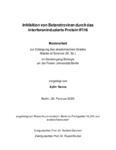Inhibition von Betaretroviren durch das interferoninduzierte Protein IFI16
Savas, Aylin
Neben der Funktion als Immunsensor besitzt das interferon-induzierte Protein 16 (IFI16) auch
eine hemmende Wirkung auf verschiedene Viren, die noch wenig verstanden ist. In dieser Arbeit
wurde untersucht, ob die antivirale Wirkung von IFI16 auch bei Betaretroviren, insbesondere
dem humanen endogenen Retrovirus K (HML-2) auftritt. Die HERV-K(HML-2)-Familie ist die
jüngste Familie der HERVs und enthält mitunter weitgehend intakte Proviren, die offene
Leserahmen für alle viralen Genprodukte besitzen. Für diese Arbeit wurde ein Molekularklon
verwendet, in welchem alle postinsertionalen Mutationen, die sich vermutlich im Laufe der
Evolution angesammelt haben, revertiert wurden. Es konnte gezeigt werden, dass IFI16 in der
Lage ist, HERV-K113, ein Mitglied der HERV-K(HML-2)-Familie zu hemmen, was durch die
Aktivität der Reversen Transkriptase in den Überständen der transfizierten Zellen bewertet
wurde. Durch die Untersuchung eines CMV-HERV-K113-Konstruktes, welches anstelle der U3-
Region der LTR einen CMV-Promotor besitzt, konnte gezeigt werden, dass die virale LTR eine
wichtige Rolle für die Hemmung durch das IFI16 spielt. Eine virale Restriktion des Jaagsiekte-
Schaf-Retrovirus (JSRV) und des Maus-Mammatumor-Virus (MMTV) durch IFI16 konnte nicht
gezeigt werden. Für die Analyse standen jedoch nur Konstrukte zur Verfügung, die nicht die
gesamte virale LTR enthalten. Aus diesem Grund ist es trotz der Ergebnisse mit den
vorhandenen Konstrukten weiterhin recht wahrscheinlich, dass das IFI16 in der Lage ist, die
virale Partikelproduktion dieser Viren zu inhibieren, denn JSRV und MMTV sind dem HERVK(
HML-2) sehr ähnlich und gehören wie diese ebenfalls zu den Betaretroviren. Das
Kernlokalisierungssignal des IFI16 ist essenziell für seine antivirale Wirkung, wodurch begründet
werden kann, dass die Hemmung durch IFI16 im Kern der Zelle stattfindet. Die HIN-Domänen
des IFI16 sind im Gegensatz dazu nicht von Belang, was die antivirale Funktion des Proteins
betrifft, denn die Pyrin-Linker-Domäne des IFI16 war ausreichend für den antiviralen Effekt. Bei
Transfektion des Molekularklons oriST-HERV-K113 und einer späteren Transfektion des IFI16
konnte keine Hemmung mehr gezeigt werden, wonach die Hemmung des IFI16 vermutlich in
den frühen viralen Replikationsschritten ansetzt. Wurde das IFI16 in den Zellen, welche mit
oriST-HERV-K113 transfiziert wurden, bereits vorher transfiziert, wurde entgegen der
Erwartungen keine verringerte virale Partikelproduktion gemessen. Dieser Umstand lässt
vermuten, dass nur durch die gleichzeitige Transfektion der Plasmide gesichert werden kann,
dass die Zellen beide Plasmide aufnehmen und exprimieren. Durch die Infektion von Zellen, die zuvor mit IFI16 transfiziert wurden, mit einem HERV-GFP-Reportervirus, konnte außerdem gezeigt werden, dass das IFI16 keinen Einfluss auf den Einbau des Virusgenoms in das Genom der Zellen hat und somit seine Hemmung erst nach dem Einbau entfaltet. Aside from its function as an immune sensor, the interferon-inducible protein 16 (IFI16) has an
antiviral effect on different viruses. In this work the antiviral effect of IFI16 on betaretroviruses
was determined, particularly on the human endogenous retrovirus K (HML-2). The HERVK(
HML-2) family is the youngest family of HERVs and occasionally includes intact proviruses
with open reading frames for all viral gene products. The molecular clone of HERV-K113, which
was used for this work, is a construct, where all postinsertational mutations were reverted. The
results show that IFI16 is able to inhibit HERV-K113, a member of the HERV-K(HML-2) family.
The inhibition was determined by the activity of the reverse transcriptase in the supernatant of
the transfected cells. Analysis of a CMV-HERV-K113 construct, where the U3 region is replaced
by a CMV promotor, showed that the viral LTR is important for the inhibition by IFI16. If the U3
region is replaced, the inhibition of HERV-K113 is much lower than the inhibition of the construct
with the complete LTR. Analysis of the Jaagsiekte Sheep Retrovirus (JSRV) and the Mouse
Mammary Tumor Virus (MMTV) showed no inhibition by IFI16. For this experiment there were
only constructs available, in which the U3 region of the viral LTR is replaced by a CMV promoter.
Therefore, it is still likely that IFI16 is able to restrict JSRV and MMTV in the presence of a full
viral LTR. The nuclear localization signal is essential for the antiviral effect of IFI16, whereby it
was shown that the restriction takes part in the nucleus of the cell. In contrast, the HIN domains
seem to be dispensable, because the pyrin-linker domain of the IFI16 is sufficient for the
restriction of HERV-K113. If the molecular clone oriST-HERV-K113 was transfected and the
IFI16 was cotransfected at later points in time, the antiviral effect was gone, so it seems like the
inhibition takes part in the early steps of viral replication. If the IFI16 was transfected first and the
oriST-HERV-K113 was cotransfected at later points in time, there was, contrary to expectations,
no antiviral effect. It seems like only simultaneous transfection of both plasmids can guarantee
that the cells incorporate and express both plasmids. Furthermore, 293T cells were transfected
with IFI16 and later infected with a HERV-GFP reportervirus. The results indicate that the
infection of the cell and the integration of the viral genome into the genome of the host cell is not
inhibited by IFI16 and thereby the viral restriction seems to appear after integration.
Files in this item
No license information

